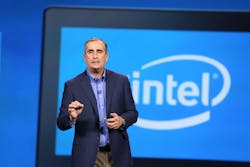Brian Krzanich, Intel's Chief Executive, Resigns Over Employee Relationship
Brian Krzanich resigned as Intel's chief executive officer following an investigation into his consensual relationship with another employee. The decision cuts short his efforts to diversify the company into the automotive and machine learning market. It also follows persistent manufacturing missteps and the waning of the personal computer business that has financially powered it for decades.
Intel said that an ongoing investigation by internal and external counsel had shown that Krzanich violated the company’s “non-fraternization” policy by having a past relationship with another employee. The company said in a statement that the policy applies to all managers inside the company and that there's an expectation that all employees will follow Intel’s code of conduct and respect its values. Krzanich is also resigning from Intel's board of directors.
Filling Krzanich’s position for now is Robert Swan, Intel’s chief financial officer, who currently leads global finance, informational technology, and corporate strategy. The board of directors said it was weighing permanent replacements for Krzanich, who has served as chief executive since 2013. The company is looking both internally and externally, though it traditionally promotes from within its engineering ranks.
The company followed that playbook in hiring Krzanich. He was 22-years-old when Intel hired him as an electrical engineer in 1982. He was promoted to management roles within Intel's manufacturing division and began overseeing its semiconductor factories and supply chain in 2007. He served as chief operating officer before being promoted to chief executive, taking over for former chief executive Paul Otellini, who had been in charge since 2005.
Over the next five years, Krzanich aimed to reduce Intel’s dependence on PCs. His focus was on shifting the business into powering billions of devices connected to the cloud. Intel has burned through billions of dollars to buy programmable chip maker Altera, machine learning startups Nervana Systems and Movidius, and advanced driver assistance system supplier Mobileye. At the same time, the company exited markets like virtual reality, wearables, cyber security and embedded software.
The growing pains have been significant. Two years ago, Krzanich enacted the largest restructuring the company’s history, in which around 15,000 jobs worldwide were eliminated as the company moved resources out of the PC business. He started poaching rival executives to fill holes in Intel’s ranks and to manage its growing archipelago of businesses. Venkata Renduchintala, who was hired from Qualcomm, is widely considered to have an inside track on Krzanich's job.
Intel is also struggling to hold onto its fundamental technology lead. That could give rivals like Advanced Micro Devices a chance to steal market share in data centers and PCs. Intel shifted volume production of chips based on 10-nanometer technology to next year, behind Taiwan Semiconductor Manufacturing Corporation and Samsung, both of which are skipping ahead to 7 nanometers. Low manufacturing yields have complicated its production plans.
And then there have been Krzanich’s gaffes. Last year, the chief executive raised eyebrows when he sold roughly $39 million of Intel stock before the disclosure of the Meltdown and Spectre vulnerabilities in Intel’s chips, which could allow passwords and other secrets to be swiped from memory. Krzanich reduced his holdings to 250,000 shares, the bare minimum he could hold as chief executive of the company. Intel said that the sale was unrelated to the security revelations.
Over the last two years, Intel’s fortunes have improved. The Santa Clara, California-based company increased its quarterly revenue forecast on Thursday from $16.3 billion to $16.9 billion. Profits are expected to be 99 cents per share, up from its previous estimate of 85 cents. That comes after company’s stock price jumped 27 percent last year, when it reported revenue of $62.8 billion, up around six percent from $59.4 billion in 2016.
About the Author
James Morra
Senior Editor
James Morra is the senior editor for Electronic Design, covering the semiconductor industry and new technology trends, with a focus on power electronics and power management. He also reports on the business behind electrical engineering, including the electronics supply chain. He joined Electronic Design in 2015 and is based in Chicago, Illinois.

